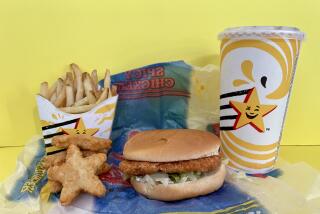Out to Lunch : Children Elevate Brown-Bag Items to New Category of Cuisine
- Share via
Concealed in the list of items to be auctioned at a school--a weekend at a cabin in Julian, a day at a health spa, 6 dozen golf balls, gift certificate for The Gap, and surfboard, was an item that truly appealed to me and fetched an impressive donation. Item No. 62: Exciting, nutritious and delicious brown bag lunches for your family for one month.
Child development specialists have never fully explored the depth of the school lunch on the evolution of a child. Interrogate any child over the age of three as to what they did at school and the reply may sound vague, “Oh, nothing. We played. We did work.” However, ask a child what they ate for lunch, or moreover, what their best friend had for lunch, and you will receive a detailed description. “He had a bagel with cream cheese, those neat cheese flavored chips I love, four dinosaur chocolate cookies, a new grape drink I hope you will get the next time you go to the store, and I think some fruit.”
I, however, have never discounted the importance of “what’s in the lunch,” having noted as a teacher that the impending lunch period and the contents of one’s lunch are not matters to be lightly considered.
The saga of our lunch program closely parallels advances made in the food, beverage, and packaging industry in the last two decades.
Commencing with the now outdated metal lunch pails and thermoses with glass interiors, the former, which rusted after a fortnight’s usage, and the later, which invariably broke, the parade of lunch boxes in our home mirror the toy industry--Barbie, GI Joe, My Little Pony, The Rescuers, Star Wars, He-Man--Care Bears and Teenage Mutant Ninja Turtles. Strangely, with the advent of the more durable plastic-molded versions of lunch boxes, the appeal of the character on the box often diminished before the lunch pail was deemed unusable. In the past two years, I was successful in weaning all four children from lunch pails to the brown bag. (I invite any environmentalist who chastises such waste of paper to come and wash out four lunch pails on a daily basis.)
The discussion of the lunch should begin with the main course--the sandwich.
Naturally, our oldest child never had anything other than whole grain or whole wheat bread with her sandwich. Over the years, begging, pleading, and whining have had some effect on my bread decision-making. In recent months, I have been seen purchasing Wonder bread. The placement of this white, plastic, colorful balloon wrapped bread on the kitchen countertop was greeted with nothing less than wild enthusiasm.
My friend Susan always baked her own bread for her family. Her children had sandwiches of the variety that teachers take notice. However, one day her child queried if they might have that kind of bread she had seen other children having--you know--the kind that slices all the same and comes from a store.
I am indebted to the bagel industry for two out of three lunches every week.
As for contents of sandwiches, I have encouraged “hands-on experiences” in the kitchen with the preparation in that some like honey not jelly with their peanut butter, some prefer Dijon mustard with their meat sandwich, some like mayonnaise with their tuna fish others prefer Miracle Whip, whereas another group is refraining from the ingestion of tuna altogether because of allegations of porpoise harassment, others insist on the lettuce packaged separately from the sandwich to retain freshness. Someone should study whether specificity with respect to lunches has any correlation with adjustment to adult living situations.
Among notable innovations in the 21st Century, I would like to list prepackaged juices. I have not forgotten that special surprise of opening a thermos that had been misplaced for a couple days and being overwhelmed by the aroma of spoiled milk, fermented apple or orange juice.
I judiciously pack a fresh fruit and vegetable in the lunch. Over the years, observing the eating habits of children in the school setting, I can honestly say that I am not certain my children consume these needed nutrients. Their presence in the lunch, however, exonerates me from the guilt of not providing a well-balanced meal with all the four food groups.
The augmentation of the lunch with regard to dessert and chips is the domain in which most children focus their attention.
It is with this portion of the lunch that the child develops the essential life-skill of bartering. Whether a school condones or discourages “trading,” it flourishes in either a covert or open manner. Adults may perceive two homemade chocolate-chip cookies as highly marketable items. However, in the school lunch setting, the price associated with a new chip item or special dessert being marketed on television may carry a higher value. Two cupcakes with chocolate icing are not even closely similar if one also has rainbow sprinkles on it.
Children will confer extensively before the actual trade and others at the table are frequently consulted as to the “fairness” of the deal. There is also the unspoken rule of “no backs” once the deal is in place.
This program of bartering did reach a new level at our home last year when a certain 16-year-old male was heard to say to his older sister, who was graciously preparing lunches, “Put some more alfalfa sprouts on that please, I get a better price.” The legality of selling his second sandwich was discussed in depth.
Finally, how does one eliminate the need to constantly replenish supplies for the lunch?
One family had a solution for this dilemma. They shopped once a week and divided the juice, desserts and chips into separate piles for their children. If one child felt the need “to eat through his week” before Friday, he had to live with the consequences of a meager sandwich and milk.
More to Read
Eat your way across L.A.
Get our weekly Tasting Notes newsletter for reviews, news and more.
You may occasionally receive promotional content from the Los Angeles Times.










